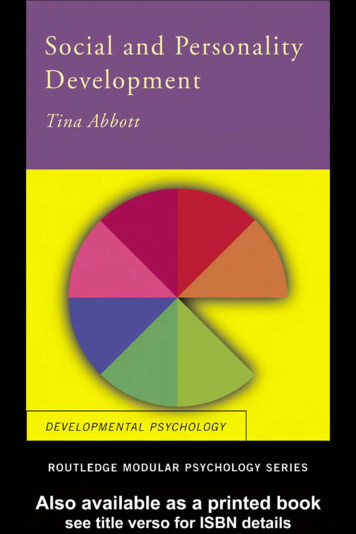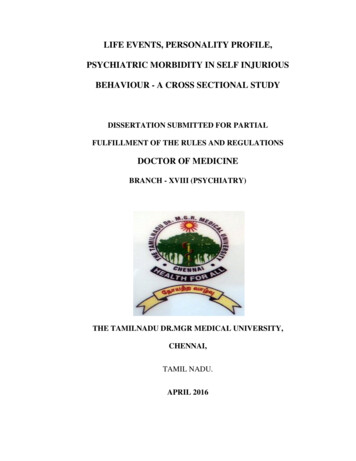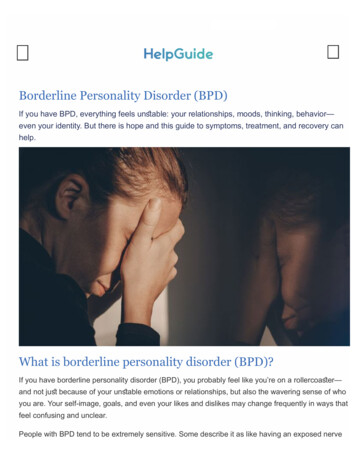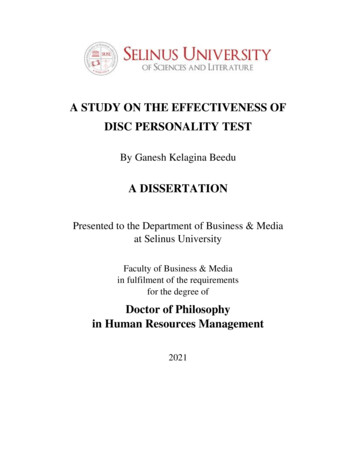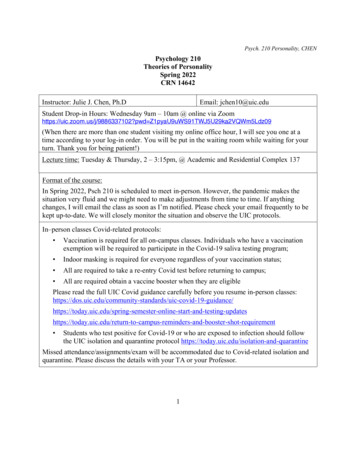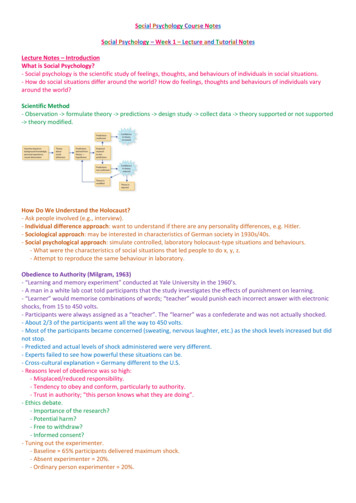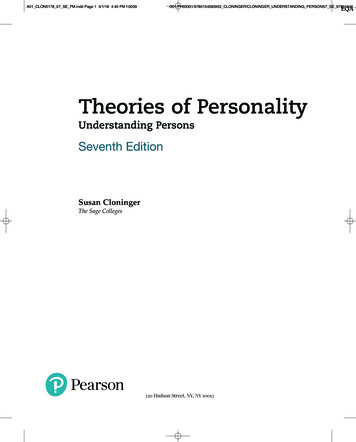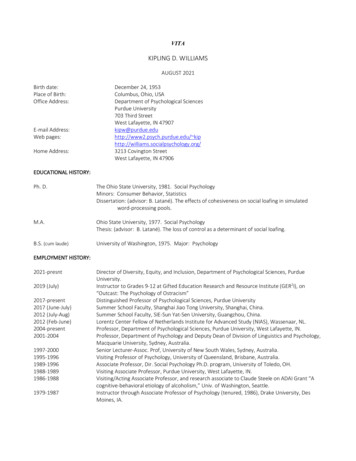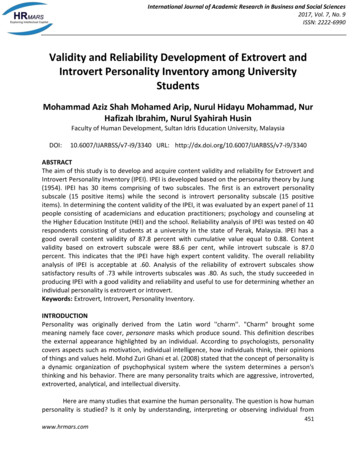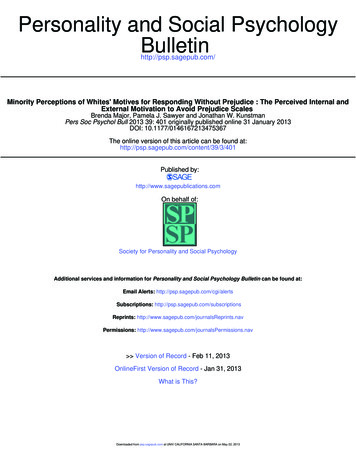
Transcription
Personality and Social PsychologyBulletinhttp://psp.sagepub.com/Minority Perceptions of Whites' Motives for Responding Without Prejudice : The Perceived Internal andExternal Motivation to Avoid Prejudice ScalesBrenda Major, Pamela J. Sawyer and Jonathan W. KunstmanPers Soc Psychol Bull 2013 39: 401 originally published online 31 January 2013DOI: 10.1177/0146167213475367The online version of this article can be found d by:http://www.sagepublications.comOn behalf of:Society for Personality and Social PsychologyAdditional services and information for Personality and Social Psychology Bulletin can be found at:Email Alerts: http://psp.sagepub.com/cgi/alertsSubscriptions: http://psp.sagepub.com/subscriptionsReprints: ions: http://www.sagepub.com/journalsPermissions.nav Version of Record - Feb 11, 2013OnlineFirst Version of Record - Jan 31, 2013What is This?Downloaded from psp.sagepub.com at UNIV CALIFORNIA SANTA BARBARA on May 22, 2013
475367ality and Social Psychology BulletinMajor et al.PSPXXX10.1177/0146167213475367PersonMinority Perceptions of Whites’Motives for Responding WithoutPrejudice: The Perceived Internaland External Motivation to AvoidPrejudice ScalesPersonality and SocialPsychology Bulletin39(3) 401 –414 2013 by the Society for Personalityand Social Psychology, IncReprints and permission:sagepub.com/journalsPermissions.navDOI: 10.1177/0146167213475367pspb.sagepub.comBrenda Major1, Pamela J. Sawyer1, and Jonathan W. Kunstman2AbstractWhites’ nonprejudiced behavior toward racial/ethnic minorities can be attributionally ambiguous for perceivers, who maywonder whether the behavior was motivated by a genuine internal commitment to egalitarianism or was externally motivatedby desires to avoid appearing prejudiced to others.This article reports the development of a scale that measures perceptionsof Whites’ internal and external motives for avoiding prejudice (Perceived Internal Motivation Scale/Perceived ExternalMotivation Scale [PIMS/PEMS]) and tests of its internal, test–retest, discriminant, convergent, and predictive validity amongethnic minority perceivers. Minorities perceived Whites as having internal and external motives for nonprejudiced behaviorthat were theoretically consistent with but distinct from established measures of minority-group members’ concerns ininterracial interactions. Tests of the predictive validity of PIMS/PEMS showed that when a White evaluator praised themediocre essay of a minority target, minorities who were high PEMS and low PIMS were most likely to regard the feedbackas inauthentic and derogate the quality of the essay.Keywordsprejudice, attributional ambiguity, stigma, intergroup processes, interracial interactionReceived November 30, 2011; revision accepted November 12, 2012Strong egalitarian norms in contemporary American societydiscourage racial prejudice and discrimination (Bobo, 2001;Crandall, Eshleman, & O’Brien, 2002). Individuals seen asracists are stigmatized in many quarters of society and subjected to social as well as legal sanctions (e.g., Civil RightsActs of 1964, ). Overall, antiprejudice norms greatly benefitsociety by helping to decrease overt forms of racial prejudice (Blanchard, Crandall, Brigham, & Vaughn, 1994).Strong antiprejudice norms may also, however, makeWhites’ positive behavior toward ethnic minorities attributionally ambiguous (Crocker & Major, 1989). When Whitespraise ethnic minorities, or otherwise treat them favorably,especially under ambiguous circumstances, perceivers mayquestion whether the behavior was motivated by a genuineinternal commitment to egalitarianism or was externallymotivated by desires to avoid appearing prejudiced to others(Plant & Devine, 1998). As a result, perceivers may sometimes be uncertain whether positive feedback from Whitesis genuine.This dilemma of discernment is especially salient forminority recipients, and may have important implications fortheir behavior, cognition, interracial relationships, and selfperceptions (e.g., Aronson & Inzlicht, 2004). Yet, surprisingly little is known about how minorities perceive Whites’motives for behaving in positive, nonprejudiced ways. Thecurrent work addresses this question. We report the development and validation of a measure assessing ethnic minorities’perceptions of Whites’ motives to avoid prejudice, and its twosubscales, the Perceived Internal Motivation Scale (PIMS)and the Perceived External Motivation Scale (PEMS).1University of California, Santa Barbara, USAMiami University, Oxford, OH, USA2Corresponding Author:Brenda Major, Department of Psychological and Brain Sciences, Universityof California, Santa Barbara, 552 University Road, Santa Barbara, CA93106, USAEmail: brenda.major@psych.ucsb.eduDownloaded from psp.sagepub.com at UNIV CALIFORNIA SANTA BARBARA on May 22, 2013
402Personality and Social Psychology Bulletin 39(3)Paradoxical Responses of EthnicMinorities to Positive FeedbackFrom WhitesSeveral studies suggest that under certain conditions, ethnicminorities may, paradoxically, react negatively to positiveinterpersonal feedback from Whites. For example, Crocker,Voelkl, Testa, and Major (1991) found that African Americanstudents’ self-esteem decreased following positive interpersonal feedback from White peers when they believed theirrace was known, but not when they believed their race wasunknown. Hoyt, Aguilar, Kaiser, Blascovich, and Lee (2007)replicated this finding among Latina American students andalso showed that the more they attributed Whites’ positivefeedback to race, the worse they felt about themselves. Inanother demonstration (Mendes, Major, McCoy, & Blascovich,2008), Black students who received positive interpersonalfeedback from a White partner (who knew their race) showeda threat pattern of cardiovascular responses, and performedworse on a cognitive task compared with Black students whoreceived positive feedback from a Black partner, or Whitesregardless of condition. Collectively, these and other studies(e.g., Schneider, Major, Luhtanen, & Crocker, 1996) suggestthat ethnic minorities sometimes respond negatively to positive feedback from Whites.What explains these paradoxical results? We suggest thatthey may reflect minorities’ uncertainty about the authenticity of some types of positive responses from Whites.Specifically, minorities’ belief that (some) Whites are prejudiced coupled with awareness that sanctions are (sometimes)imposed on Whites who exhibit prejudice may lead them tosuspect that positive feedback from Whites is motivated byexternal pressures, such as the desire to avoid appearing prejudiced to others, rather than by real liking or respect. Thissuspicion may be activated when Whites’ responses towardminorities appear to be “overly” positive or ambiguous withregard to whether it was deserved. For example, in the studies described above, minorities received highly positiveinterpersonal feedback from a previously unknown Whitepeer who knew little about them. Under such circumstances,they may have been uncertain whether the feedback wasauthentic. Uncertainty, particularly as it relates to the self, isaversive (van den Bos, 2009). Consequently, individualswho are uncertain of the authenticity of positive feedbackmay react negatively to it.Avoiding the Appearance ofPrejudice and the Role of PositiveResponsesMinorities often have good reason to question positiveovertures from Whites. Contemporary racial prejudice isoften covert, subtle, and indirect (Dovidio, Kawakami, &Gaertner, 2002). Whites’ explicit racial attitudes are oftenmore positive than their implicit attitudes (e.g., Greenwald& Banaji, 1995) and their public responses to ethnic minorities are often more positive than their private responses(e.g., Plant & Devine, 2001). Antiprejudice norms contribute to this discordance. Because of the stigma associatedwith being seen as a racist (Crandall et al., 2002), Whitesexperience evaluation apprehension and often regulate theirthoughts, feelings, and behavior to avoid appearing prejudiced in interracial interactions (Stephan & Stephan, 1985).Whites also sometimes act especially positively to minorities to signal that they are not prejudiced (e.g., Richeson &Shelton, 2007). For example, Whites evaluated Black jobapplicants more favorably than identically qualified Whiteapplicants (Carver, Glass, & Katz, 1978) and evaluatedessays ostensibly written by Black students more favorablythan when the same essays were ostensibly written byWhite students (Harber, 2004).Internal and External Motivation toRespond Without PrejudicePlant and Devine (1998) suggested that two motives underlie Whites’ positive responses toward minorities. Whitesmight be internally motivated to treat minorities fairlybecause of personally important egalitarian beliefs andmight also be externally motivated to treat minorities positively to avoid the social repercussions of being labeled aracist. Plant and Devine developed the Internal (IMS) andExternal (EMS) Motivations Scales to measure thesemotives. IMS and EMS are independent constructs that predict behavior above and beyond explicit measures of prejudice (Kunstman, Zielaskowski, & Plant, 2012). Whereasexplicit measures of prejudice reflect evaluative responsestoward racial out-groups, IMS and EMS assess individuals’distinct motivations to respond without prejudice because ofpersonal commitments to egalitarianism (IMS) and socialpressures (EMS).Whites motivated purely by internal factors (i.e., highIMS/low EMS) exhibit low levels of implicit and explicitprejudice, and tend to be most engaged and approach-orientedin interracial settings (e.g., Devine, Plant, Amodio, HarmonJones, & Vance, 2002; Plant, Devine, & Peruche, 2010). Incontrast, Whites motivated exclusively by social concerns(i.e., high EMS/low IMS) display the highest levels of prejudice and most negative response toward minorities (e.g.,Devine et al., 2002; Plant & Devine, 1998). Furthermore,they sometimes respond positively toward minorities in public, but negatively when the threat of social sanctions isremoved (Plant & Devine, 2001). Whites motivated by internal and external factors (i.e., high in IMS and EMS) oftenhave genuine egalitarian beliefs, but also have difficulty regulating biased responses (e.g., Amodio, Devine, & HarmonJones, 2008). Thus, minority-group members frequently facea complex attributional problem when assessing nonprejudiced behavior on the part of Whites. Surprisingly, despiteDownloaded from psp.sagepub.com at UNIV CALIFORNIA SANTA BARBARA on May 22, 2013
403Major et al.extensive research examining how Whites’ motives forresponding without prejudice affect their behavior, researchhas tested neither how minorities perceive these motives norhow these meta-perceptions shape their responses to positivetreatment directed toward themselves or other minorities. Thecurrent research fills this empirical gap.Current Research: Minority-GroupPerceptions of Majority GroupMotivesWe propose that minorities beliefs about Whites’ motives fornonprejudiced behavior are based on their perceptions ofintergroup relations and their personal experiences. Someminorities perceive intergroup relations with Whites to benegative or conflicted, whereas others perceive them to begenerally positive or cooperative. Minorities who believeintergroup relations are generally positive, or who interactregularly with Whites who are egalitarian publically andprivately, may come to believe Whites are primarily internally motivated to respond without prejudice. As a result,they are likely to interpret positive feedback directed towardthemselves and other minorities as genuine. Conversely,minorities who perceive intergroup relations with Whitesgenerally as negative, or who interact with Whites whoappear friendly only when egalitarian social pressures arepresent, may come to believe Whites’ nonprejudiced behavior is motivated more by external than internal concerns. Asa result, they are likely to view positive feedback with suspicion. These latter individuals may be especially (or primarily) likely to suspect the authenticity of feedback fromWhites when it seems “overly” positive or does not seemcommensurate with their own or other minority-group members’ performance. The belief that positive feedback is disingenuous may explain why minorities sometimes shownegative affective, cognitive, and physiological reactions topositive feedback from Whites.The current research tested these ideas in three stages. InPhase 1, we created a measure of perceptions of Whites’internal (PIMS) and external (PEMS) motivations to respondwithout prejudice, modeled after Plant and Devine’s (1998)IMS/EMS. We administered the PIMS/PEMS to Black andLatino students and analyzed its resultant factor structureand internal and test–retest reliability.In Phase 2, we tested the convergent and divergent validityof the PIMS/PEMS subscales. We hypothesized that responseson the PIMS/PEMS would be modestly associated with constructs assessing minorities’ intergroup concerns, includingstigma consciousness (SC; Pinel, 1999), race-based rejectionsensitivity (RS-race; Mendoza-Denton, Downey, Purdie,Davis, & Pietrzak, 2002), negative attitudes toward Whites(Landrine & Klonoff, 1996), and perceived discrimination atthe personal and group level. We also tested how responseson the PIMS/PEMS relate to ethnic identification, generalpersonality factors associated with social cognition (e.g., general distrust of others, autonomy, locus of control, attributional style) and to personal well-being (e.g., anxiety, hostility,depression, and self-esteem).Finally, in Phase 3, we conducted two studies to test thepredictive validity of the PIMS/PEMS. We hypothesizedthat ethnic minorities who score high on PEMS and low onPIMS would be more likely than those with other perceivedmotivations to see a White peer’s highly positive evaluationof a minority target’s mediocre essay as externally motivated and inauthentic, and as a result, would be less positivein their evaluation of the minority target’s work. We furtherexpected that this would be unique to their evaluations offeedback to minority targets and not extend to evaluationsof White targets.Phase 1: Scale DevelopmentWe first developed and tested a measure of perceived internal and external motives for Whites’ nonprejudiced behavior. Using Plant and Devine’s (1998) 10-item scale as aguide, we altered the IMS/EMS to reflect perceptions ofWhites motives. PIMS/PEMS has 10 items: Five assess perceptions that Whites are internally motivated to respondwithout prejudice (PIMS; for example, “When White peopleact in a nonprejudiced way toward members of racial/ethnicminority groups, it is because it is personally important tothem not to be prejudiced”), and five assess perceptions thatWhites are externally motivated to respond without prejudice (PEMS; for example, “White people act in a nonprejudiced way toward members of racial/ethnic minority groups,it is because they are trying to avoid disapproval fromothers”). See Table 1. Although PIMS/PEMS may be independent like IMS/EMS, minorities may also perceiveWhites’ motives to be correlated—either positively or negatively—in ways that Whites’ actual motives are not.MethodScale Construction. Participants from two samples indicatedtheir agreement with the 10 PIMS/PEMS items on separate0 (completely disagree) to 6 (completely agree) Likert-typescales. See Table 1 for descriptive statistics. We conductedexploratory factor analysis (EFA) on the first sample andconfirmatory factor analysis (CFA) on the second sample.For clarity of presentation, the two samples are describedprior to presentation of analyses.Participants. Minority participants completed the PIMS/PEMS in exchange for course credit. Sample 1 consisted of515 undergraduates (Mage 19.1, SD 4.17; 72% female)enrolled in a Western public university in the United States.Of these, 481 identified as Hispanic/Latino, and 34 identifiedas African American/Black.1 Sample 2 consisted of 252undergraduates (Mage 19.2, 71% female). Of these, 222Downloaded from psp.sagepub.com at UNIV CALIFORNIA SANTA BARBARA on May 22, 2013
404Personality and Social Psychology Bulletin 39(3)Table 1. Factor Loadings from Exploratory Factor Analysis of the Perceived Motives to Avoid Prejudice Scale (Sample 1)When White people act in a nonprejudiced way towardmembers of racial/ethnic minority groups, it is because . . .They want to avoid negative reactions from othersIt is personally important to them not to be prejudicedIt is in accordance with their personal values to beunprejudicedThey believe it is wrong to use stereotypes aboutmembers of racial/ethnic minority groupsThey feel pressure from others to act nonprejudicedThey think other people would be angry with them ifthey acted prejudicedThey are personally motivated by their beliefsThey want to avoid disapproval from othersIt is important to their self concept to be unprejudicedThey are trying to act politically correctMSDRangeReliability (α)Factor 1 (PIMS)Factor 2 (PEMS) 0.0120.6700.8240.6540.099 0.1130.791 0.043 0.1630.2050.7820.5380.772 0.0270.7030.0593.740.8731.00-6.000.812 0.0520.8220.2510.7073.110.8670.00-6.000.742Note: PIMS perceived internal motivation scale; PEMS perceived external motivation scale. N 515. Items falling on a factor are in boldface.identified as Hispanic/Latino and 30 identified as AfricanAmerican/Black.ResultsSample 1 EFA. With the data from Sample 1, we conducted anEFA on the 10-item scale. A principal-components factoranalysis with varimax rotation revealed the hypothesizedtwo-factor structure (see Table 1). Factor 1 had an eigenvalue of 2.94 and accounted for 29.2% of the variance in therotated sums of squares loadings. Factor 2 had an eigenvalueof 2.56 and accounted for 25.8% of the variance. Factor analyses revealed similar results when we analyzed Latinos andBlacks separately.Factor 1 is consistent with the hypothesized PIMS subscale, with high values reflecting perceptions that Whites’are motivated to respond without prejudice for internal, personal reasons. Factor 2 is consistent with the hypothesizedPEMS subscale, with high values reflecting greater beliefsthat Whites’ nonprejudiced behavior is motivated by socialconcerns with appearing prejudiced.Sample 2 CFA. To cross-validate the hypothesized model, wenext conducted a CFA on the data from Sample 2 with AMOSsoftware, using maximum likelihood estimation of the data’scovariance matrix. The hypothesized 10-item model testedthe hypothesis that the PIMS/PEMS scale consisted of twocorrelated latent variables—PIMS, based on responses onItems 2, 3, 4, 7, and 9; and PEMS, based on responses onItems 1, 5, 6, 8, and 10. This model achieved adequate modelfit, χ2(34) 96.23, p .001; comparative fit index (CFI) .95; root mean square analysis (RMSEA) .085 (90% confidence intervals [CI] [.066, .106]); Akaike’s informationcriterion (AIC) 158.23. To the extent that the two proposedmotivations merely reflect a general perception that Whitesare motivated to behave in a nonprejudiced manner, a singlefactor solution should provide a better fit to the data than theproposed two-factor solution. For this reason, an alternativeone-factor model was also tested. This resulted in very poormodel fit, χ2(35) 680.34, p .001; CFI .45; RMSEA .271 (90% CI [.253, .289]), AIC 740.34, suggesting thata two-factor model fits the data better than a one-factorstructure. Indeed, a chi-square difference test revealed thatthe two-factor model fit the data significantly better than theone-factor model, χ2(1) 584.11, p .001.Reliability and Correlation of the PIMS and PEMS. Althoughshort scales sometimes suffer from low reliability, the PIMSand PEMS demonstrated adequate internal reliability in bothsamples. Cronbach alphas ranged from .63 to .88 for thePIMS and from .76 to .85 for the PEMS. We also examinedtest–retest reliability by asking a third sample of participants(n 22, Mage 20) to complete the PIMS/PEMS online attwo different time points, 4 to 6 weeks apart. Test–retest reliability of the PIMS was r .86 and that of the PEMS was r .53, suggesting that scores on the latter scale are more sensitive to situational variables.Notably, the PIMS and PEMS were uncorrelated (Sample1, r .09; Sample 2, r .13). Paired samples t tests revealedthat overall, participants in Samples 1 and 2 perceivedWhites to be significantly more motivated to respond without prejudice for internal (M 3.74; 3.75) than for externalDownloaded from psp.sagepub.com at UNIV CALIFORNIA SANTA BARBARA on May 22, 2013
405Major et al.reasons (M 3.11; 3.03); t(514) 12.05, p .001; t(250) 7.27, p .001. Both Blacks and Latinos showed thispattern.DiscussionData from Samples 1 and 2 support PIMS/PEMS’ two-factorstructure, suggesting that minorities perceive distinct internal and external motives for Whites’ positive behavior. ThePIMS/PEMS also demonstrated sound internal and test–retest reliability. Correlations also suggest that PIMS/PEMSare independent constructs. Thus, some minorities are highin PEMS (low PIMS), others high PIMS (low PEMS),whereas still others are simultaneously high and low in bothmotivations. Data also suggest that at the mean level, minorities in these samples (primarily Latinas) saw Whites’ nonprejudiced behavior as more internally than externallymotivated. Thus, only certain minorities regard Whites asprimarily motivated to respond without prejudice for external reasons. In Phases 2 and 3, we tested the convergent,divergent, and predictive validity of these scales.Phase 2: Convergent andDiscriminant ValidityWe tested the convergent and discriminant validity of PIMS/PEMS by assessing their relationships with existing measures of stigma-related concerns, ethnic identification, andgeneral personality characteristics.1 We predicted modest,positive relationships between PEMS and distrusting attitudes toward Whites, expectations of being stereotyped orrejected because of one’s ethnicity, personal and group experiences with prejudice, and perceived social pressure onWhites to inhibit prejudice. We reasoned that minoritiessuspicious of Whites’ motives would be particularly likely toperceive social pressures on Whites to inhibit prejudice andview intergroup relations with Whites negatively. By contrast, as PIMS assesses beliefs that Whites are genuinelyegalitarian, we expected PIMS to be inversely related tonegative attitudes toward Whites. We did not expect ethnicidentification to be related to PIMS or PEMS, as minoritieswho identify highly with their ethnic group may perceiverelations with Whites as either negative or positive.We also tested PIMS/PEMS’ relationships with generalinterpersonal distrust, perceptions of control, locus of control and attributional style. We predicted that PEMS mightbe modestly correlated with distrust—reflecting a generaltendency to question the motives of others—but did notanticipate a similar relationship with PIMS. We also speculated that people with an internal attributional style or locusof control might be more likely to perceive Whites behavior as internally motivated (high PIMS), whereas thosewith an external attributional style might be more likely toperceive Whites as motivated by external, social factors(high PEMS).We also tested the relationships of the PIMS/PEMS subscales with self-esteem (Rosenberg, 1965) and mental health(feelings of depression, anxiety, and hostility; Derogatis,1993). We did not expect PIMS or PEMS to be related tomental health or self-esteem.In addition to testing the unique relationships amongPIMS/PEMS and the above variables, we also examinedhow these variables relate to the relative extent to whichminorities’ perceive Whites as externally versus internallymotivated to respond without prejudice. We subtracted PIMSfrom PEMS to create a Suspicion of Motives Index (SOMI).We expected that minorities who score high on the SOMI(i.e., those who see Whites’ motivation as more external thaninternal) would score the highest on measures of stigma concerns and perceived prejudice.MethodParticipants. Students who self-identified as Latino/a completedthe PIMS/PEMS and additional scales of interest online, typically during departmental mass testing sessions. Sample 1 (515participants described above) completed measures of perceivedpersonal and group discrimination, self-esteem, and ethnic discrimination. Sample 2 (n 222, Mage 19.20, 71% female)completed measures of SC, interpersonal trust, and well-being.Sample 3 (n 177, Mage 19.40, 71% female) completed measures of RS-race and White distrust. Sample 4 (n 51, 67%female) completed measures of locus of control and attributional style. Sample 5 (n 180, Mage 19.14, 67% female)completed a measure of ethnic identification. Sample 6 (n 15,60% female) completed a measure of perceived social pressureon Whites to inhibit prejudice toward Latinos.MeasuresThe Stigma Consciousness Questionnaire (SCQ;Pinel, 1999; Sample 2) measures expectations ofbeing stereotyped because of one’s race or ethnicity.Respondents indicate their agreement with 10 statements (e.g., “Stereotypes about my ethnic/racialgroup have not affected me personally” [reversed]).The RS-Race (Mendoza-Denton et al., 2002; Sample3) assesses concerns about and expectations ofinterpersonal rejection in 12 different scenarios dueto race or ethnicity (e.g., experiencing racial profiling in shopping center). Following standard procedures, expectations, and concerns were multiplied,and then averaged across the 12 scenarios.The Interracial Attitudes Subscale of the AfricanAmerican Acculturation Scale (AAAS; Landrine &Klonoff, 1996; Sample 3) measures attitudes towardand distrust of Whites. Respondents indicate theiragreement with seven statements (e.g., “I don’t trustmost White people;” “Deep in their hearts, mostWhite people are racists”).Downloaded from psp.sagepub.com at UNIV CALIFORNIA SANTA BARBARA on May 22, 2013
406Personality and Social Psychology Bulletin 39(3)Perceived personal discrimination (Sample 1) wasassessed with a single item, “I experience discrimination because of my ethnicity” (e.g., Major, Kaiser, O’Brien, & McCoy, 2007).Perceived ethnic group discrimination (Sample 1) wasassessed with two items: “My ethnic group is discriminated against” and “Other members of my ethnicityexperience discrimination” (Major et al., 2007).Ethnic identification (Sample 5) was measured withLuhtanen and Crocker’s (1992) 4-item identity centrality scale (e.g., “The ethnic group I belong to isan important reflection of who I am”).Perceived social pressure on Whites to inhibit prejudice (Sample 6) was assessed with a single item:“How much social pressure is there to not displayprejudice against Latino people?” responded on ascale from 1 (none) and 7 (a lot).Interpersonal Trust Scale (ITS; Yamagishi, 1986;Sample 2) is a six-item measure of interpersonaltrust (e.g., “I am trusting”).Personal Control Scale (Pearlin & Schooler, 1978;Sample 1) assesses feelings of control over one’slife, with 7 items (e.g., “What happens to me in thefuture mostly depends on me”).The Locus of Control scale (Rotter, 1966; Sample4) has 13 pairs of internal (e.g., “Trusting fate hasnever turned out as well for me as making a decision to take a definite course of action”) and external(e.g.,” I have often found that what is going to happen will happen”) statements. Participants select thestatement in each pair they agree with most. Highervalues indicate a more internal locus of control.The Attributional Style Questionnaire (ASQ; Peterson et al., 1982; Sample 4) measures attributionsfor 6 positive (e.g., “You become very rich”) and 6negative (e.g., “You can’t get all the work done others expect of you”) events on 1 (totally due to otherpeople or circumstances) to 7 (totally due to me)scales. Attributions for positive and negative eventsare scored separately.The Rosenberg Self-Esteem Inventory (RSE; Rosenberg, 1965; Sample 1) is a widely used 10-itemmeasure of global self-esteem.The Brief Symptom Inventory (BSI; Derogatis, 1993;Sample 2) is a validated measure of mental healthsymptoms. Participants indicated the frequencywith which they experience symptoms assessed bythe 6-item depression, 6-item anxiety, and 5-itemhostility subscales.ResultsCorrelations between the PIMS, PEMS, SOMI (PEMS–PIMS), and the above measures are shown in Table 2. Samplesizes vary as not all participants completed all measures.Table 2. Correlations of PIMS, PEMS, and SOMI With PerceivedStigmatization, Interpersonal Trust, Personal Control, andPsychological Well-Being ConstructsConstructPerceived stigmatizationPerceived group discriminationPerceived personal discriminationEthnic stigma consciousnessEthnic identityRace-based rejection sensitivityInterracial attitudesPressure on WhitesEthnic identityInterpersonal trustPersonal control/masteryAttributional StylePositive eventsNegative eventsLocus of controlPsychological well-beingGlobal PIMSPEMSSOMI25925926018011711715180252227 .09 .05.15*.01 .23* .05 .01 .18**.17**.08.12*.03.32***.45***.52**.03 .08 .18**515151.40***.06.30** .19 .02 .05 .42*** .06 .24* .08.15*.14*.09 .10*.06.11*.18**515227227227.06.07 .01 .17*Note: PIMS perceived internal motivation scale; PEMS perceived external motivation scale; SOMI Suspicion of Motives Index (PEMS – PIMS); BSI Brief SymptomInventory. Not all participants completed every scale.*p .10. **p .05. ***p .01.Relationships With Stigma Concerns. As expected, scores onthe PEMS were positively and significantly correlatedwith ethnic SC (r .33), ethnic-based rejection sensitivity(r .22), and negative attitudes toward Whites (r .36).PEMS was also marginally associated with perceptions ofeth
ality and Social Psychology BulletinMajor et al. 1University of California, Santa Barbara, USA 2Miami University, Oxford, OH, USA Corresponding Author: Brenda Major, Department of Psychological and Brain Sciences, University of California, Santa Barbara, 552 University Road, Santa Barbara, CA 93106, USA Email: brenda.major@psych.ucsb.edu
